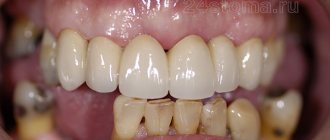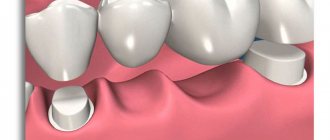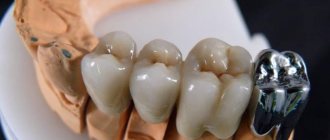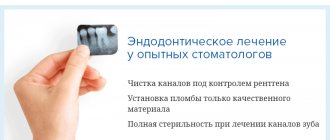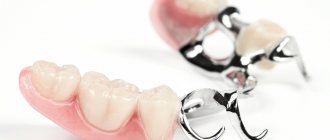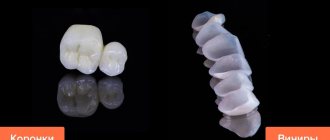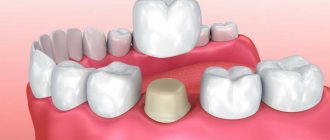Temporary dental crowns are a type of dental prosthesis that are placed in place of a permanent crown while it is being made. The creation of a permanent structure can last from a couple of weeks to a month, and thanks to a cheaper denture, a person can chew freely during this time, smile without embarrassment and not feel the absence of one of the teeth.
| Temporary crown: prices | |
| Installation of a temporary crown | 1,200 rub. |
Temporary crown at the GDenta clinic - installation of high-quality material at reasonable prices and on favorable terms. What do we offer to our clients?
The production of removable dentures occurs much faster than permanent dental structures. In addition, they are fixed with temporary cement - this material gradually dissolves, so the period of wearing the prosthesis is limited. How much a temporary crown costs depends on the material from which it is made, as well as the method of installation.
What problems do temporary tooth crowns solve?
- preventing gum overgrowth;
- maintaining the aesthetic appearance of the dentition;
- protection of soft dental tissues from bacteria;
- preventing displacement of adjacent teeth;
- preservation of articulatory and chewing functions;
- acceleration of adaptation of the oral cavity to a permanent prosthesis.
Purpose
During prosthetics, the procedure of tooth preparation is carried out and temporary crowns are necessary to protect the oral cavity from unwanted and even harmful influences; in addition, such crowns allow you to maintain the aesthetics of the dentition after grinding problem teeth. It should also be taken into account that when installed on the teeth, they relieve the patient from discomfort, since ground molars lose their main functionality, and also make it possible to correctly distribute the load during implantation.
How to care for a temporary prosthesis
They require the same meticulous care as real teeth. If this is not done, food will accumulate, resulting in inflammatory processes in the gums. Swelling and pain will appear.
The problem area for dentures is the area of connection with natural teeth and their lower part. To prevent plaque from accumulating in these places, you need to use a medium-hard toothbrush at an angle of 45 degrees. It is useful to rinse your mouth after eating. Herbal decoctions (chamomile, calendula, sage) are suitable for these purposes, but you can also use ready-made pharmaceutical products.
When wearing a removable dental structure, it must sometimes be placed in a special liquid. To prepare the solution, denture tablets are used, for example, Protefix or Corega. The liquid must be changed after each use. In addition, when wearing non-permanent models, you should use the following tips:
- do not eat too hard foods;
- reduce the load on the area in which the prosthesis is located;
- Use floss to brush your teeth very carefully, avoiding sudden movements.
Advantages
Considering the somewhat lengthy treatment process, issues of the aesthetic appearance of the patient’s oral cavity acquire particular importance and significance; it is these considerations that dictate the need to use provisional crowns. Their key advantages are:
- no pressure on the supporting tooth, which allows the patient not to feel pain;
- such crowns provide the patient with excellent protection from gum growth and the effects of various microorganisms;
- the tooth does not shift;
- while wearing such a crown, the patient gradually gets used to the foreign body in his oral cavity;
- there is no violation of diction;
- to some extent, restoration of lost functions is carried out, albeit to a small extent.
Materials for production
The most common and popular material for making temporary crowns in dentistry is now plastic or composite. This is explained by a large number of their advantages:
- speed of hardening;
- ease of modeling a plastic crown;
- almost zero toxicity level;
- high strength of the finished product;
- the ability to perform crown adjustments at almost any time;
- short production time;
- relatively short wearing period.
These advantages, of course, serve as serious arguments in favor of plastic crowns, but one cannot ignore their disadvantages, namely:
- the possibility of complications due to penetration of microorganisms deep into the porous structure of the crown;
- poor resistance to dyes and color changes;
- the maximum service life does not exceed two years.
Methods, process and manufacturing steps
They can be produced with equal success both in the laboratory and in the dental office. The second option is good because it takes only two to three hours, but the shape and color of such a product will distinguish it from other teeth, but if the production takes place in a laboratory, the quality of the result will be higher, although it will take more time, approximately two or three days.
There are several methods for making crowns from plastic, in particular, the direct method, when the product is performed immediately in the dental chair according to the following algorithm:
- Taking an impression of the problematic tooth, its neighbors and the antagonistic jaw. The manufacturing material is softened silicone mass.
- After the silicone has hardened, the tooth is turned, on which a crown of both temporary and permanent properties will be installed.
- The material chosen for manufacturing is poured into the impression and it is placed on the ground tooth.
- Removing the impression, grinding and polishing the surface to bring it into proper shape, after which the final fixation of the prosthesis is performed using cement
This entire procedure lasts approximately one hour; the cement used to fix the prosthesis gradually dissolves under the influence of human saliva.
Accordingly, the indirect method is based on laboratory production of the product. This procedure is carried out by a technologist who gets his hands on a cast for making plaster blanks. Taking into account all the features of his existing models, he produces a prototype using special wax. As a result of such painstaking work, the prosthesis is made in full accordance with the patient’s jaw and is highly reliable.
Contraindications for installation
In some situations, you cannot install temporary models. If the patient has had any infections in the mouth, it is necessary to wait until complete healing occurs. If the doctor is not completely sure whether the prosthesis will take root, you also need to wait some time. After the reasons for doubts have disappeared, the question of implantation can be raised again. Usually, the installation of a prosthesis can rarely be interfered with. But if the patient has been diagnosed with inflammation of the oral tissues, it is necessary to refrain from using prosthetics.
The duration of addiction depends on the individual characteristics of the body. In some cases this happens within 2 hours. However, people often cannot adapt to removable dentures for a long time.
It is important to remember these points:
- There shouldn't be any pain. If pain occurs, it means something was done incorrectly.
- If the amount of saliva produced has changed in any direction (it has become more or less), this indicates a poor quality of the procedure.
- To make the adaptation process faster, it is useful to perform a special massage. You need to hold the crown with your index finger and use your thumb to massage it along the gum (in a spiral, up and down, with light pressure).
Restrictions on use and prohibitions
The use of temporary crowns is not always feasible and possible; there are certain restrictions on their use in such situations:
- It is not recommended to install prostheses for children under 12 years of age;
- if you are allergic to the materials used in prosthetics;
- when a patient experiences a phenomenon such as teeth grinding or bruxism;
- in cases of inflammation of the problem area of the oral cavity;
- if the patient has a deep bite;
- when identifying certain mental disorders.
For those who do not pay enough attention to oral hygiene, it is not recommended to install plastic dentures due to the fact that the porous structure of the material itself serves as a breeding ground for pathogenic bacteria.
How to make an appointment with a dentist in Moscow
The GDenta clinic offers affordable prices for temporary crowns. You can also get an installment plan without interest, so don’t delay treatment! Our dentistry uses modern equipment and medicines, we introduce innovative methods of dental restoration. Each patient receives a guarantee for our services, including the installation of prostheses. Prosthetics at the GDenta clinic is a gentle procedure, because we are concerned about the physical and psychological comfort of patients.
Sign up for a consultation by phone: +7 (495) 312 2504 and +7 (925) 891 8353. We are waiting for you at the address: Moscow, st. Podolsk cadets, 3.
Indications for installation of prostheses
Installation of temporary plastic prostheses is carried out for the following indications:
- in situations where various types of damage to teeth visible to others have occurred, for example, when the enamel has darkened or the patient is not satisfied with their size;
- crowns are placed on chewing teeth in order to preserve a person’s ability to eat well and eat any food;
- before a complete reconstruction of the teeth is carried out, temporary crowns are placed on the ground molars in order to protect them from various external influences;
- to prevent overgrowth of the gum bed;
- to prevent displacement of teeth in a row;
- If you have periodontal disease, you cannot splint your teeth without temporary crowns;
- in order to restore the patient’s diction;
- for the purpose of covering implants when installing a permanent prosthesis.
When are provisional crowns used?
If the dental tissue has been destroyed by more than half, prosthetics cannot be avoided. Tooth filling is possible only for minor carious cavities. Making a permanent prosthesis in place of a previous tooth is a labor-intensive undertaking that takes (in addition to financial costs) a significant amount of time. Therefore, during orthopedic implantation, it is customary to install provisional crowns, which not only preserve the aesthetic appearance, but also make it easier for the patient to eat.
Designs for molars
Normal and nutritious human nutrition is impossible without chewing teeth, since the entire load during chewing food falls on them. Accordingly, as soon as the first problems with the condition of such teeth appear, you should immediately consult a doctor and arrange for the installation of dentures. However, it is necessary to understand that the choice of plastic crowns must be approached carefully and carefully; if you select unsuitable prostheses, this will not correct, but will only worsen the situation.
It is better to give preference to those prostheses that have the longest service life; we must not forget that the structures have to undergo very serious impacts and not the highest quality plastic can easily and quickly fail. Metal-ceramics and ceramics on paper look like a more preferable option, but, firstly, they are significantly more expensive, and, secondly, if you incorrectly calculate the bite or pressure force when installing them, then chips or cracks may form on the prosthesis, and this will cause serious inconvenience for the patient.
Care
- Brush your teeth thoroughly twice a day, without putting excessive pressure on the denture;
- limit the chewing load in the area of prosthetics;
- eliminate hard, sticky foods;
- limit foods and drinks that can stain the prosthesis material (coffee, tea, red wine, etc.);
- do not wear the device for longer than the period recommended by the dentist;
- If the prosthesis is displaced or damaged, immediately contact the dentist.
Article Expert
Alekperov Roman Borisovich Dentist-orthopedist, doctor of the highest category
Work experience: more than 31 years
The process of removing temporary crowns
The very concept of “temporary crowns” means that after a certain period they must be removed, otherwise their functionality and appearance will no longer meet the requirements. How are such dentures removed? If metal ceramics were installed, then it must be sawed; this is not required for plastic, since this material does not have a high level of strength. First of all, the doctor will need to weaken the effect of the substances used to fix the prosthesis with the help of special drugs. Using a drill, a Copa apparatus and ultrasound, the process of gradual removal of the product is carried out. It is worth pointing out to patients that this procedure is painless and anesthesia is almost never required.
After the prosthesis is removed and the tooth is cleaned of the remaining fixing materials, the next temporary crown or a permanent one is installed. The decision in favor of one option or another must be made after consultation with a doctor. You also need to remember that a permanent crown is also limited in service life, but longer than a temporary one.
Solution for lateral incisors
If there is a lack of lateral teeth, choosing a suitable model is quite difficult. The following options for temporary dentures are possible during the implantation period:
- A non-permanent, non-removable crown, the installation of which results in removal from the bite. This method is possible if the patient is missing one tooth. It is necessary that the bone tissue is dense. It should be enough to fix the prosthesis. Overbite means that the artificial tooth will be lower than the real incisors. This will not only improve aesthetics, but also reduce the load on the prosthesis. After the artificial root has taken root, the doctor will install a permanent crown (made of zirconium dioxide or metal-ceramic). This usually happens after 3-5 months.
- Fixed prosthesis made of metal-plastic. Used only to replace many or all of the incisors in the mouth. For this method, special implants are used, installed at an angle. The prosthesis is an artificial gum and metal-plastic crowns. The model is fixed for 2-3 years and does not cause discomfort at all. With its help you can chew food freely.
- Removable "butterfly". A standard immediate denture made of a crown and a plastic base. It is installed with support on the patient’s gums.
- Removable mouthguard. This option is suitable for partial edentia. Natural teeth are required to fix the structure.
Removable "butterfly"
Care and how long can you wear them?
The duration of use of a temporary prosthesis is limited not only by its performance characteristics, but is also determined by its proper care. There is nothing complicated about this, care should consist of such simple things as:
- lower level of load on the area of the oral cavity where the prosthesis was installed;
- in this place, when brushing your teeth, you should perform gentler actions, without applying much force;
- After using dental floss, you should not pull it out, but carefully and calmly pull it out.
When answering the question of how long you can wear temporary dentures, you should remember that delaying this procedure does not justify itself. As soon as the permanent structure is ready, it is rational to replace the temporary prosthesis with it.
Possible problems and consequences
Unfortunately, the installation of temporary dentures does not always go smoothly. There are unpleasant situations that sometimes arise even when wearing dentures for a short period of time. List of the most common problems:
- formation of chafing;
- gum inflammation and stomatitis;
- change in cheek position.
Such consequences most often appear due to a lack of qualifications of the dental technician, non-compliance with the dentist’s recommendations, as well as an individual reaction of the body that could not be foreseen. If temporary crowns are too close to the gum, prosthetic stomatitis occurs. The structure puts pressure on the gums, blood circulation is disrupted, and the tissues in this area die. In order to avoid serious consequences, the doctor prescribes mouth rinsing with hydrogen peroxide and antiseptics.
If free space is left in order to avoid strong pressure on the gums, then food will get there, which can cause caries. However, with careful oral hygiene, the likelihood of tooth decay will decrease.
Sometimes the patient may be allergic to the materials from which the dentures were made. This situation is very difficult to predict, since the reason for this is still not fully understood. When tissues and structures come into contact, an adverse reaction occurs. Most often this is expressed in such manifestations as an asthmatic attack, rash, burning sensation and the formation of plaque on the tongue.
Whatever the problem, if any unpleasant symptoms appear, you should immediately visit a doctor. He will remove the structure and replace it with a product made of a different material.
What to do if it falls out?
It happens that the installed temporary crown comes off. It is quite natural that patients are concerned about this situation and if it has happened, what to do next? First of all, there is no reason to panic; you should return it to its place yourself, fixing it with Vaseline or toothpaste and be sure to consult a dentist. The structure returned to its place on its own will, of course, not have the same strength and reliability, but it will still perform its basic functionality. It should also be remembered that it is better to remove the prosthesis before going to bed, this will avoid the potential serious consequences of its night loss.
Voice of the people
If we analyze the reviews of patients who resorted to installing plastic crowns, we can say that for many of them they became a real salvation. They are perfect for young girls who, due to their age, cannot yet install metal-ceramics and do not have complexes about their smile, for example, at school.
It is also noted that it is necessary to use plastic structures only on a temporary basis, since it is not possible to fit such a crown tightly onto the tooth, and it becomes a breeding ground for harmful microorganisms. Many patients say that as a temporary measure, such prostheses are almost an ideal solution to the problem, plus, their cost is quite affordable.
Actions to take if a prosthesis falls out
Temporary structures should not be worn for a long period. If the prosthesis falls out, you should immediately visit a doctor to have it reattached. Under no circumstances should you try to solve the problem yourself. Such actions can lead to serious consequences, especially if the patient used ordinary glue.
Temporary dentures are an excellent solution for maintaining an aesthetically attractive appearance and restoring chewing function. Although such designs are quite comfortable, you should not wear them for a long time. Short-term models can be used for long-term wear only because not every person has access to more expensive prostheses. Knowing this, you should follow preventive measures, carefully care for artificial teeth and regularly visit the dentist.
